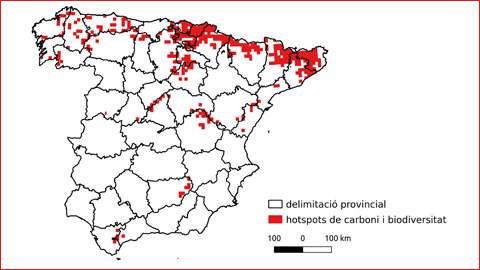Forests storing more carbon also have more biodiversity
A research group led by CREAF and with the involvement of the UAB has discovered that the forest with the largest amounts of carbon in Spain are also the ones to harbour more diversity of tree and bird species, and vice versa. The study has given way to a map with the areas in which both properties are highest.

The research team, in which UAB and CREAF researcher Javier Retana participated, were able to verify that a hotspot is created when there are many trees close together and different species with varying structures (tall and short trees, more branches or less branches). "The more trees a forest has, the more carbon it can capture. If we add the fact that the trees are different, then they compete less for soil and other resources, can grow more and have more space for more species. In the case of forest birds, the more compressed and varied the forest is, the more variety of food and places to build a nest it will have”, Lecina-Diaz states. At the same time, researchers found isolated mountain areas with steep slopes in which the amount of carbon stored is high and there is a larger variety of trees and birds. “Humans normally do not have access to these places and the trees and birds found here grow better than when exposed to human pressure”, the main author of the study concludes.
Where are the most valued forests located?
Judit Lecina-Diaz and the team formed by researchers from CREAF, the Forest Science and Technology Centre of Catalonia (CTFC), the University of Santiago de Compostela and the UAB included alongside the report a map with the location of the most prized forests in terms of carbon storage and biodiversity. The forests are located close to the Cantabrian Sea, mainly in the Basque Country, north of Navarra, Asturias and parts of Galicia; in the Pyrennees, pre-Pyrennees, Catalan Pre-Coastal Range and the Els Port massif of Catalonia and Valencia; on the inside of the peninsula there are the Sierra de Cebollera in La Rioja; the Sierra de Grazalema in Andalusia; the Serranía de Cuenca in Castilla la Mancha; the Cuenca Alta del Manzanares and the Sierra de Guadarrama in Madrid.
The study was also conducted in Canada, with a group of international collaborators from Portugal and Canada who reached equivalent conclusions in the area of Quebec.
This research can aid in making decisions focused on environmental management policies. There is a need for forestry management and conservation policies to take these two indicators (carbon storage and biodiversity) into account, as well as the variables which often affect them. Given the fact that if one indicator improves so does the other one, it will be possible to devise effective management measures for both the environment and climate change mitigation.
Article: Lecina‐Diaz, J., Alvarez, A., Regos, A., Drapeau, P., Paquette, A., Messier, C., & Retana, J. (2018). The positive carbon stocks‐biodiversity relationship in forests: co‐occurrence and drivers across five sub‐climates. Ecological Applications.